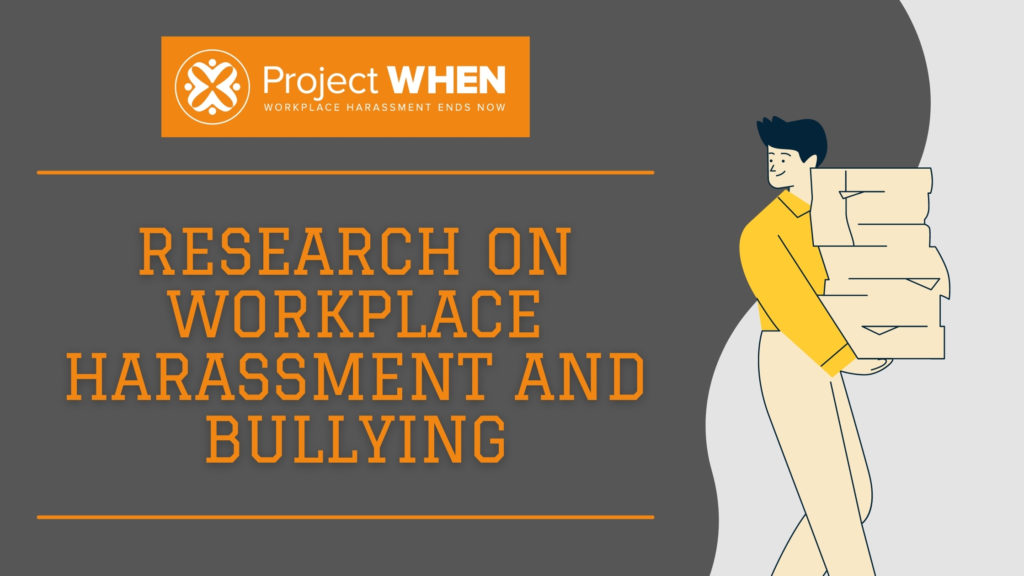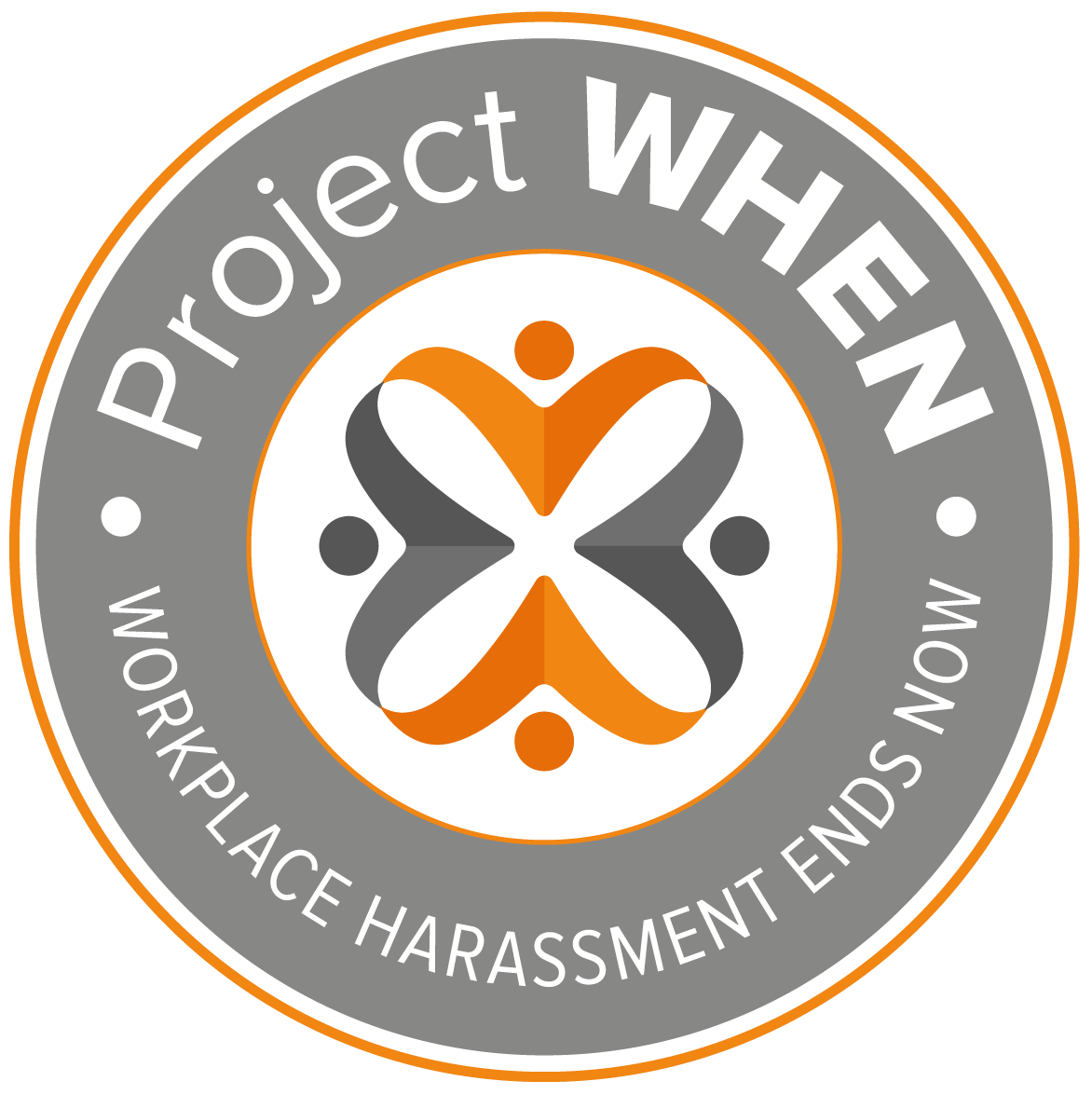Research on the Causes and Impact of Harassment in the Workplace

An Overview on Workplace Harassment
Project WHEN (Workplace Harassment Ends Now) is working hard to stand behind our mission of elevating awareness of workplace harassment and encouraging organizations and individuals to start driving change. The undeniable truth is that harassment and bullying can occur in any place of employment.
Therefore, a huge piece of our organization’s work is researching all areas of workplace harassment and the different factors that are impacting work cultures. Our goal for this research is to get to the root of the issue and identify implementable solutions.
This page highlights our valuable findings that organizations in different industries can leverage to instill respectful behaviors in the workplace. We are pleased to share the key aspects of our exploration, as well as bring people closer to other research and resources that offer important information on preventing and addressing workplace harassment.
Project WHEN’s Research on Harassment in the Workplace
➤ The Definition of Harassment
Project WHEN defines workplace harassment as “unwanted conduct to include all areas of workplace harassment, including sexual and physical harassment, quid pro quo harassment, microaggression, bullying, ageism, job shaming, verbal threats, derogatory comments, discriminating or exclusionary behavior, and other forms of offensive behaviors.”
➤ Examples & Types of Harassment at Work
- Sexual and physical harassment. Can range from leering at a part of your body, jokes or other verbal remarks of a sexual nature, to unwanted touching or rape.
- Quid pro quo harassment. Sexual coercion; “Your career in the company would be on the fast track if you weren’t so uptight. You need to join me at the annual sales convention in Las Vegas.
- Microaggression. “You did a really nice job in your team’s presentation…for a woman.”
- Bullying. “This report is full of errors. I could have asked my kid to do this report and had less hassle in fixing your stupid mistakes.”
- Ageism. “OK Grandpa, get the lead out. I’d like to get this project wrapped up before I’m a senior citizen.”
- Job shaming. “He’s only the janitor. His opinion doesn’t count.”
- Verbal threats. “I swear I’ll put my fist through this wall if I need to explain this to you one more time.”
- Derogatory remarks. Comments exhibiting a lack of respect toward someone, degrading remarks, or expressions of criticism, hostility, or disregard.
- Discriminating or exclusionary behavior. “I want Bill, Mike, Joe, and Brian to work on this assignment.” Somehow, Ahmed, Vishnu, Mohammed, and Alejandro have yet to be selected to participate on a special projects team.
➤ Intent Versus Perception
Project WHEN defines harassment as unwanted behavior of a nature that violates your dignity, makes you feel intimidated, degraded or humiliated, and creates a hostile or offensive work environment. It’s about how you perceive the behavior and/or how you feel, rather than the intention of the harasser. The harasser may not intentionally be trying to offend you. Or he/she may tell you they were only kidding. It doesn’t matter what he/she set out to do, whether maliciously or innocently. It’s harassment if YOU perceive that it is.
➤ Outside the Walls of the Workplace
 The work environment extends beyond the corporate office. The term ‘workplace’ includes business trips, company-organized events, conferences or other industry events, meetings outside the office which are work related, including dinners, drinks, golf outings, etc.
The work environment extends beyond the corporate office. The term ‘workplace’ includes business trips, company-organized events, conferences or other industry events, meetings outside the office which are work related, including dinners, drinks, golf outings, etc.
- Workforce opinions about how to treat other people are not manufactured completely within an organization. Employees walking into a workplace do not leave their personal experiences on the doorstep (even if they tried).
- Employees’ personal attitudes can contribute to an already toxic work environment.
- Similarly, the attitudes we experience within the workplace can, in fact, taint how we interface with others in our personal lives.
➤ The WHEN Perspective on Workplace Harassment
Project WHEN (Workplace Harassment Ends Now) recommends taking a holistic approach to eliminating workplace harassment. With a goal of addressing systemic harassment for all employees, an all-encompassing methodology must be adopted.
- Activities associated with eliminating workplace harassment should not be focused exclusively on women.
- The appropriate harassment reduction strategy can support a number of other key areas of focus for the business:
- Diversity, equality, and inclusion initiatives
- Attracting, retaining and inspiring top talent
- Enhancing the employee experience and engagement
➤ The Impact of the Critical Influences in Creating Organizational Culture of Respect
Diane Stegmeier, founder of Project WHEN is also the CEO of Stegmeier Consulting Group, a change consulting firm. As a global thought leader in change management and workplace research, she recognized that one of the most important change initiatives that organizations should be focusing on is creating respectful, harassment-free workplaces for future generations.
Deriving from her extensive research on resistance to workplace change and important findings on the 15 Critical Influences™ compiled in her book, Innovations in Office Design: The Critical Influence Approach to Effective Work Environments, Project WHEN offers the concept of Organizational Culture of Respect which focuses on a number of factors that influence behavior in the workplace.
These factors are also known as Critical Influences™ and they can contribute to the creation of a culture of respect in the organization’s work environment. If left unchecked, the influence of these factors can negatively impact the corporate culture, and can establish a toxic workplace where harassment can flourish.
Ten Influences on Behavior in the Workplace
- Culture
- Leadership Behavior
- Image & Reputation
- Rewards & Consequences
- Organizational Structure
- Compensation
- Communication
- Core Values
- Accountability
- Physical & Virtual Workplace
Impact of Influences on a Culture of Respect
| Influence | Impact |
| Culture | The existing culture of the organization influences behaviors–good and bad. When a toxic work culture exists, there are numerous opportunities for harassment to occur. Culture is one of the most difficult things for companies to change. When attempting to eradicate workplace harassment, many organizations will develop a vision of exactly what the senior leadership (with employee feedback) would like the culture to be. This is an excellent first step to understand the current situation before trying to envision the desired future culture of respect. |
| Leadership Behavior | Employees look to the organization’s leaders for direction on how they should behave in the workplace. When those in management positions bully subordinates, spew out microaggressions, discriminate, or worse–sexually harass employees–it sends a signal loud and clear that there is a lack of respect permeating the corporate culture. |
| Image & Reputation | An organization’s culture is influenced by the public’s perception of what it must be like for employees who work there. When companies receive bad publicity, such as for sexual harassment claims reported by the local or national news, employees’ sense of pride is negatively impacted, influencing whether or not a culture of respect can exist. |
| Rewards & Consequences | What are the consequences of bad behavior in the organization? “Super star” employees (example: the top sales representative who brings in millions of dollars of sales to the company) who bully those in administrative support roles, may receive no consequences for this unwanted behavior. This results in a culture of disrespect. |
| Organizational Structure | Often, organizations with a large number of hierarchical levels are more formal, with an increasing amount of power the higher the level. Corporate politics are often evident in the culture. These organizations are more prone to incidents of harassment, thus preventing a culture of respect. |
| Compensation | Compensation can impact whether or not harassment occurs in a workplace. Those in lower levels may struggle financially, and don’t report incidents of harassment for fear of losing their job. Those individuals may be treated with less respect due to a toxic culture. |
| Communication | Communication is crucial to creating a culture of respect. Does the organization articulate to the workforce that harassment will not be tolerated? Are employees encouraged to report unwanted behaviors that make them uncomfortable? Actually telling employees that they ARE respected is a powerful first step in working towards a culture of respect. |
| Core Values | Organizations often articulate in the corporate core values phrases such as “employees are our biggest asset,” yet when harassment goes unchecked, the corporate culture of one of distrust, not respect. |
| Accountability | Culture is shaped in part by how employees (including those in senior leadership positions) are held accountable for their actions. When executives are not held accountable for harassment, it creates a workplace culture that actually encourages poor behaviors by all employees. One of the ways that a culture of respect can be established is by ensuring the company’s Board of Directors holds the C-suite accountable for harassment. |
| Physical & Virtual Workplace | Newer progressive office designs promote an open plan that signals a sense of equality amongst all employees, whether front line staff or senior leaders. This is the opposite of earlier workplace designs that reserved the spacious private offices and high-end furniture for those at the top of the company. The way in which the workplace is designed can significantly contribute to a culture of respect. More and more organizations are having employees work remotely, if their jobs allow it. When rude or bullying behaviors take place in virtual meetings, it can undermine a culture of respect. |
➤ Ongoing research into the root causes and aftermath of harassment in the workplace
Project WHEN is always looking for sponsors to help support new research studies. Service providers in the area of employment law and respectful workplaces may consider partnering with Project WHEN to sponsor the development of surveys, white papers, and research studies. As a 501(c)(3) nonprofit, these types of activities allow us to continue to raise awareness for these important issues. We will also be adding to our research findings as benchmarking data returns from organizations that have enrolled in WHEN’s organizational certification program.
Specific Industries Affected by Harassment
Harassment in the Tech Industry
Despite claims of progress, the tech industry continues to draw attention for frequently making news for workplace harassment, ranging from sexual harassment, gender inequality, racism and ageism. This page covers how tech industry leaders and employees can take a proactive approach in solving systemic harassment, and a list of workplace harassment cases in the tech industry.
Harassment in the Alcohol & Service Industry
Due to the risk factors of allowing alcohol consumption and relying on compensation (often tips) tied to client satisfaction, harassment is quite prevalent in workplaces within the alcohol and service industry. But it doesn’t mean that employers and employees are powerless against it. This page lists the things that we can do to address it, along with examples of harassment documented within the industry.
Harassment in Higher Education
Recent trends suggest that harassment is ingrained in higher education cultures. What can school administrators, faculty members, staff members, and students do to prevent and act against it? Learn that here. This page also includes real examples of harassment in higher education institutions.
 Harassment in the Government Sector
Harassment in the Government Sector
Harassment is pervasive in many industries and the government sector is no exception. But what could be influencing the existence of this systemic problem in government workplaces? This post answers this question, and a list of harassment examples that have been reported within this sector.
 Harassment in the Media and Entertainment Industry
Harassment in the Media and Entertainment Industry
The media and entertainment industry has been confronted with many stories of workplace harassment. It has become a systemic problem that requires a holistic approach. This page explores how people in the industry can prevent and combat it and provides a collection of real harassment examples within the media and entertainment industry.
 Harassment in Sports
Harassment in Sports
A culture of harassment undeniably exists in the world of sports and it has created a systemic issue that is difficult to eradicate. This page covers what leaders, sports officials, athletes, and bystanders can do to address this colossal problem. It also contains examples of harassment in the sporting world.
EEOC Research
The U.S. Equal Employment Opportunity Commission (EEOC) is also working hard to educate organizations and individuals about the importance of preventing workplace harassment. As part of their important work, the federal agency has developed a chart of risk factors for harassment at work and provided corresponding strategies that organizations can use to address such risks.
Chart of Risk Factors for Harassment and Responsive Strategies
| Risk Factor | Risk Factor Indicia | Why This is a Risk Factor for Harassment | Risk Factor-Specific Strategies to Reduce Harassment* |
| Homogenous workforce | Historic lack of diversity in the workplace
Currently only one minority in a work group (e.g., team, department, location) |
Employees in the minority can feel isolated and may actually be, or at least appear to be, vulnerable to pressure from others.
Employees in the majority might feel threatened by those they perceive as “different” or “other,” or might simply be uncomfortable around others who are not like them. |
Increase diversity at all levels of the workforce, with particular attention to work groups with low diversity.
Pay attention to relations among and within work groups. |
| Workplaces where some employees do not conform to workplace norms | “Rough and tumble” or single-sex-dominated workplace cultures
Remarks, jokes, or banter that are crude, “raunchy,” or demeaning |
Employees may be viewed as weak or susceptible to abuse.
Abusive remarks or humor may promote workplace norms that devalue certain types of individuals. |
Proactively and intentionally create a culture of civility and respect with the involvement of the highest levels of leadership.
Pay attention to relations among and within work groups. |
| Cultural and language differences in the workplace | Arrival of new employees with different cultures or nationalities
Segregation of employees with different cultures or nationalities |
Different cultural backgrounds may make employees less aware of laws and workplace norms.
Employees who do not speak English may not know their rights and may be more subject to exploitation. Language and linguistic characteristics can play a role in harassment. |
Ensure that culturally diverse employees understand laws, workplace norms, and policies.
Increase diversity in culturally segregated workforces. Pay attention to relations among and within work groups. |
| Coarsened Social Discourse Outside the Workplace | Increasingly heated discussion of current events occurring outside the workplace | Coarsened social discourse that is happening outside a workplace may make harassment inside the workplace more likely or perceived as more acceptable. | Proactively identify current events-national and local-that are likely to be discussed in the workplace.
Remind the workforce of the types of conduct that are unacceptable in the workplace. |
| Young workforces | Significant number of teenage and young adult employees | Employees in their first or second jobs may be less aware of laws and workplace norms.
Young employees may lack the self-confidence to resist unwelcome overtures or challenge conduct that makes them uncomfortable. Young employees may be more susceptible to being taken advantage of by coworkers or superiors, particularly those who may be older and more established in their positions. Young employees may be more likely to engage in harassment because they lack the maturity to understand or care about consequences. |
Provide targeted outreach about harassment in high schools and colleges.
Provide orientation to all new employees with emphasis on the employer’s desire to hear about all complaints of unwelcome conduct. Provide training on how to be a good supervisor when youth are promoted to supervisory positions. |
| Workplaces with “high value” employees | Executives or senior managers
Employees with high value (actual or perceived) to the employer, e.g., the “rainmaking” partner or the prized, grant-winning researcher |
Management is often reluctant to jeopardize high value employee’s economic value to the employer.
High value employees may perceive themselves as exempt from workplace rules or immune from consequences of their misconduct. |
Apply workplace rules uniformly, regardless of rank or value to the employer.
If a high-value employee is discharged for misconduct, consider publicizing that fact (unless there is a good reason not to). |
| Workplaces with significant power disparities | Low-ranking employees in organizational hierarchy
Employees holding positions usually subject to the direction of others, e.g., administrative support staff, nurses, janitors, etc. Gendered power disparities (e.g., most of the low-ranking employees are female) |
Supervisors feel emboldened to exploit low-ranking employees.
Low-ranking employees are less likely to understand complaint channels (language or education/training insufficiencies). Undocumented workers may be especially vulnerable to exploitation or the fear of retaliation. |
Apply workplace rules uniformly, regardless of rank or value to the employer.
Pay attention to relations among and within work groups with significant power disparities. |
| Workplaces that rely on customer service or client satisfaction | Compensation directly tied to customer satisfaction or client service | Fear of losing a sale or tip may compel employees to tolerate inappropriate or harassing behavior. | Be wary of a “customer is always right” mentality in terms of application to unwelcome conduct. |
| Workplaces where work is monotonous or tasks are low-intensity | Employees are not actively engaged or “have time on their hands”
Repetitive work |
Harassing behavior may become a way to vent frustration or avoid boredom. | Consider varying or restructuring job duties or workload to reduce monotony or boredom.
Pay attention to relations among and within work groups with monotonous or low-intensity tasks. |
| Isolated workplaces | Physically isolated workplaces
Employees work alone or have few opportunities to interact with others |
Harassers have easy access to their targets.
There are no witnesses. |
Consider restructuring work environments and schedules to eliminate isolated conditions.
Ensure that workers in isolated work environments understand complaint procedures. Create opportunities for isolated workers to connect with each other (e.g., in person, on line) to share concerns. |
| Workplaces that tolerate or encourage alcohol consumption | Alcohol consumption during and around work hours. | Alcohol reduces social inhibitions and impairs judgment. | Train co-workers to intervene appropriately if they observe alcohol-induced misconduct.
Remind managers about their responsibility if they see harassment, including at events where alcohol is consumed. Intervene promptly when customers or clients who have consumed too much alcohol act inappropriately. |
| Decentralized workplaces | Corporate offices far removed physically and/or organizationally from front-line employees or first-line supervisors | Managers may feel (or may actually be) unaccountable for their behavior and may act outside the bounds of workplace rules.
Managers may be unaware of how to address harassment issues and may be reluctant to call headquarters for direction. |
Ensure that compliance training reaches all levels of the organization, regardless of how geographically dispersed workplaces may be.
Ensure that compliance training for area managers includes their responsibility for sites under their jurisdiction Develop systems for employees in geographically diverse locations to connect and communicate. |
What can organizations and individuals do to combat workplace harassment?
 The first step to addressing workplace harassment is to acknowledge whatever the status quo may be and how you can improve it. Getting involved with Project WHEN can help organizations and individuals recognize how crucial their roles are in creating or maintaining a culture of respect in the workplace. If eliminating harassment is something you are passionate about, there are a number of ways in which you can work alongside us to achieve this common goal. Get started by signing our Pledge of Commitment to officially join our movement.
The first step to addressing workplace harassment is to acknowledge whatever the status quo may be and how you can improve it. Getting involved with Project WHEN can help organizations and individuals recognize how crucial their roles are in creating or maintaining a culture of respect in the workplace. If eliminating harassment is something you are passionate about, there are a number of ways in which you can work alongside us to achieve this common goal. Get started by signing our Pledge of Commitment to officially join our movement.
Organizations can get involved by making a tax-deductible donation to help further our cause or becoming a corporate sponsor through the sponsorship opportunities that we offer. For entities who want to initiate a meaningful conversation on workplace harassment, you can host a Project WHEN Roundtable for your executive team, HR, Diversity & Inclusion, and compliance leaders, or for your local business community.
To start taking a holistic approach in creating a harassment-free workplace, it is important to assess your work culture. Administering an anti-harassment survey can help you touch base with your employees and find potential challenges in the workplace. Project WHEN can guide your organization in deploying the Culture Pulse Survey and provide actionable data that you can use to address areas of improvement.
Pursuing WHEN™ Organizational Certification will not only allow your company to gain access to best practices in preventing harassment but will also serve as an indication of your commitment to create a harassment-free workplace to your existing and potential employees, customers, and the community.
As an individual, you can donate, as well, and ask your employer to conduct a Project WHEN Roundtable/Seminar. You can also widen your knowledge and influence in driving change by becoming an anti-harassment certified practitioner. We will soon launch a WHEN™ Professional Certification for leaders in Human Resources, Inclusion & Diversity, Legal, and Compliance roles, or any individual who wants to pursue it.
Other Research/Resources
Many researchers have been dedicating their efforts in widening studies about the different aspects of workplace harassment. Below are some pertinent papers and resources exploring sexual harassment and other types of workplace discrimination.
An article reporting the empirical test of the researchers’ proposed conceptual model identifying antecedents (organizational climate and job gender context) and consequences (effects on work-related variables, psychological state, and physical health) of sexual harassment. The model was tested by collecting and analyzing data from a sample of women in non-traditional job roles.
Harassment has a huge impact on working women. In this study, researchers use mixed methods of gathering data to examine how sexual harassment affects women’s career trajectory.
A study describing the effect of workplace culture on how sexual harassment is defined in jobs that are traditionally categorized as women’s work. Results of in-depth interviews conducted with waitresses and female nurses revealed how perceptions on sexual behaviors vary due to various work norms and factors.
This paper studies the environmental causes of sexual harassment. After gathering data from 538 nurses working in Australian hospitals and testing a model showing the correlation of organizational variables to sexual harassment, results revealed that an unbalanced job gender ratio, nurses’ negative perception of management’s leadership style, and no prior socialization all contribute to the occurrence of sexual harassment at work.
This research tests a structural equation model and examines the antecedents and consequences of sexual harassment at the personal and organizational level. Results revealed that organizational environmental factors are main predictors of harassment.
This paper tests the theory that oppressions based on gender and sexual orientation are linked. By creating a workplace harassment model, gathering data from 629 employees in higher education, and finally analyzing the collected information, researchers explored the relationship between sexual and heterosexist harassment.
Using three theories – sexual harassment, organizational climate, and employee engagement theories, this study introduces a model of how perceived anti-sexual harassment practices and incidents relate to affective commitment and intentions of employees to stay.
Comparing the theoretical antecedents and consequences of sexual assault by workplace personnel and other types of sexual harassment among women employed in the U.S. Military, this article explores the characteristics of these types of victimization.
A detailed review of scholarship about sexual harassment. Focusing primarily on men’s harassment of women, this study answers questions about the definition of harassment, why it happens, who the harassers are, its effects, and what individuals can do to address it.
A study investigating the adverse effects and prevalence of sexual harassment in a federally operated workplace. An analysis of data collected from both males and females shows that women experience sexual harassment more than men. Employees also report that gender harassment had the greatest adverse effects and was correlated with sexual harassment.
The severity of sexual harassment is often associated with the type of harassment that occurred. This study introduces a comprehensive model that includes both person and situation-level variables and explains why these are important in assessing how severe a sexual harassment incident is.
An article exploring the role of workplace power and gender expressions as a predictor of sexual harassment. Using data from the Youth Development Study (YDS), authors reveal how the battle for power, rather than sexual desire itself, can be the cause of sexual harassment.
This comprehensive guide presents a step-by-step strategy for preventing gender based violence in garment production lines in Asia which can serve as a great reference for organizations.
Drawing on three theoretical perspectives namely the attribution theory, power, and the role identity theory, this study focuses on the differences between the effects of sexual harassment from organizational insiders and organizational outsiders. Results revealed that equal opportunity support and confidence in grievance procedures have a moderating effect on addressing sexual harassment.
This research studies the differences between organizational cultures of companies with sexual harassment policies in place but still receive formal complaints over those that do not.
Acknowledging the limited research on men’s sexual harassment experiences, authors conduct a review of the literature on men’s experiences as targets of sexual harassment. This review touches on the need for organizational communication scholars to conduct more research on men’s experiences of sexual harassment.
Sexual harassment within organizations is mainly the focus of most research studies. To address the lack of research on harassment experiences at the boundaries of the workplace, this paper introduces a theoretical model of the antecedents and consequences of sexual harassment by clients and customers.


